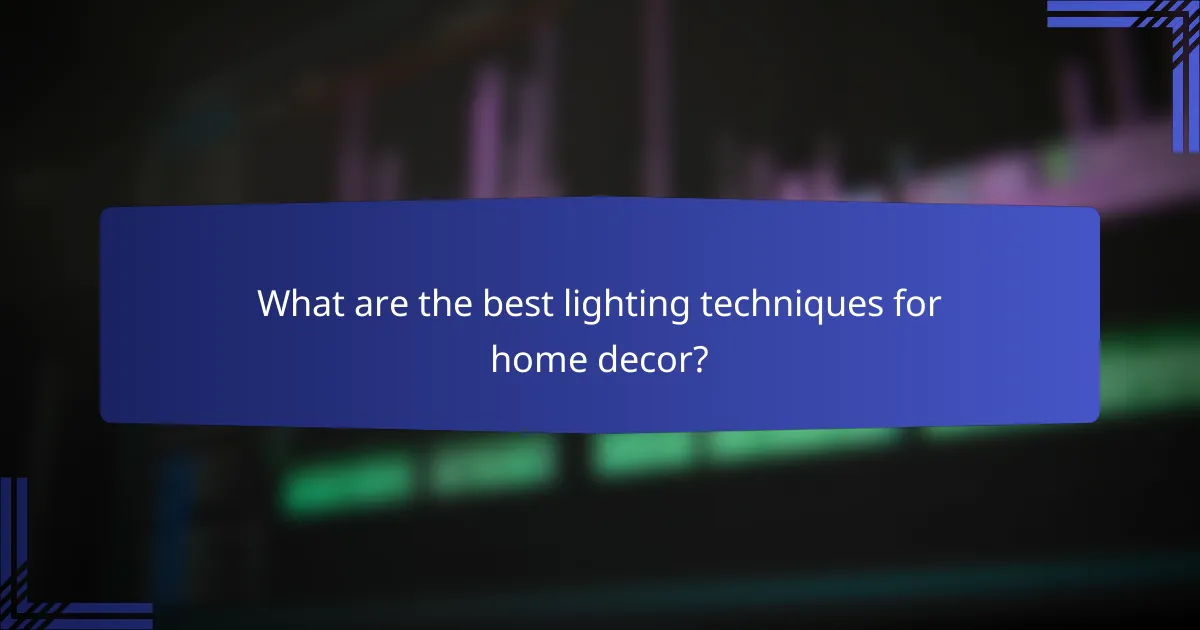Lighting layering is a powerful technique that combines various light sources to create an inviting atmosphere in any space. By integrating ambient, task, and accent lighting, you can enhance both functionality and aesthetic appeal, while also influencing mood and emotional responses through carefully chosen tones and intensities.

How to layer lighting for optimal ambiance?
Layering lighting effectively creates an inviting atmosphere by combining different types of light sources. This approach enhances functionality while adding depth and character to a space.
Use ambient lighting for overall illumination
Ambient lighting provides the foundation for a room’s illumination, ensuring that the space is evenly lit. Common sources include ceiling fixtures, recessed lights, and floor lamps that distribute light broadly.
When selecting ambient lighting, consider the size of the room and the desired brightness level. A general guideline is to aim for around 100-200 lumens per square meter for comfortable lighting.
Incorporate task lighting for specific activities
Task lighting focuses on areas where specific activities occur, such as reading, cooking, or working. Desk lamps, under-cabinet lights, and pendant fixtures are ideal for providing concentrated light where it’s needed most.
Ensure that task lighting is bright enough to reduce eye strain, typically around 300-500 lumens for workspaces. Position lights to minimize shadows and glare, enhancing both safety and comfort.
Add accent lighting to highlight features
Accent lighting draws attention to specific features in a room, such as artwork, architectural details, or plants. This type of lighting can be achieved with spotlights, wall sconces, or track lighting.
To create effective accent lighting, aim for a brightness that is about three times greater than the ambient light level. This contrast helps to create visual interest and depth, making the space feel more dynamic.

What are the best lighting techniques for home decor?
The best lighting techniques for home decor involve a combination of ambient, task, and accent lighting to create a balanced and inviting atmosphere. By layering these types of lighting, you can enhance the functionality and aesthetic appeal of any space.
Utilize chandeliers for elegance
Chandeliers serve as a stunning focal point in any room, adding a touch of sophistication and elegance. When selecting a chandelier, consider the size of the room and the height of the ceiling to ensure it complements the space without overwhelming it.
For dining areas, a chandelier can provide both ambient and task lighting, especially when hung at the right height—typically around 30 to 36 inches above the table. Choose a style that matches your decor, whether it’s modern, traditional, or eclectic.
Employ floor lamps for versatility
Floor lamps are an excellent choice for versatile lighting solutions, as they can be easily moved and adjusted to fit different needs. They work well in living rooms, bedrooms, or reading nooks, providing both ambient light and focused illumination.
When selecting a floor lamp, look for adjustable features such as dimmers or movable shades to customize the light output. Consider the lamp’s design to ensure it complements your existing decor while providing adequate lighting for various activities.
Choose wall sconces for space-saving
Wall sconces are ideal for maximizing space while adding decorative flair to your home. They are perfect for narrow hallways, small rooms, or areas where floor space is limited, providing ambient or accent lighting without taking up valuable square footage.
When installing wall sconces, consider their height and placement to ensure they effectively illuminate the desired area. Opt for styles that match your overall decor theme, and consider using dimmable options for added versatility in mood lighting.

How does lighting affect mood and atmosphere?
Lighting significantly influences mood and atmosphere by altering how we perceive our surroundings. Different lighting techniques can evoke various emotional responses, enhancing comfort, focus, or relaxation depending on the chosen tones and intensity.
Warm tones create a cozy environment
Warm lighting, typically in the range of 2700K to 3000K, fosters a sense of comfort and intimacy. This type of lighting is ideal for spaces like living rooms and bedrooms, where relaxation is a priority.
Using warm tones can be achieved with incandescent bulbs or LED options labeled as “warm white.” Consider layering these lights with soft lamps or wall sconces to create inviting nooks that encourage social interaction.
Cool tones promote focus and energy
Cool lighting, generally between 4000K and 5000K, enhances alertness and concentration, making it suitable for workspaces and kitchens. This lighting mimics daylight, which can help boost productivity and energy levels.
To implement cool tones effectively, use bright LED bulbs or fluorescent lights. Position them strategically to illuminate work areas without causing glare, ensuring a balanced environment that supports focus.
Dim lighting enhances relaxation
Dim lighting is essential for creating a tranquil atmosphere, particularly in areas designated for unwinding, such as bedrooms or home theaters. Reducing light intensity can help signal to the body that it’s time to relax.
Consider using dimmer switches or smart lighting systems that allow you to adjust brightness levels easily. Aim for a soft glow rather than complete darkness, as this can help maintain a soothing ambiance while still providing enough light for safety.

What are the key considerations for lighting design?
Key considerations for lighting design include understanding the room’s size and layout, selecting appropriate color schemes and decor styles, and evaluating the energy efficiency of lighting fixtures. These factors significantly influence the overall atmosphere and functionality of a space.
Assess room size and layout
When assessing room size and layout, consider how the dimensions and arrangement of furniture affect light distribution. Larger rooms may require multiple light sources to avoid dark corners, while smaller spaces can often be illuminated effectively with fewer fixtures.
Utilize a mix of ambient, task, and accent lighting to enhance the room’s functionality. For example, in a living room, overhead fixtures can provide general illumination, while table lamps can serve as task lighting for reading areas.
Consider color schemes and decor styles
The color scheme and decor style of a room play a crucial role in lighting design. Light colors reflect more light, making a space feel brighter and more open, while darker colors absorb light, potentially creating a cozier but dimmer atmosphere.
Match your lighting choices with the decor style; for instance, modern spaces may benefit from sleek, minimalist fixtures, while traditional settings can be enhanced with ornate chandeliers or sconces. Always consider how the light interacts with wall colors and furnishings to create a cohesive look.
Evaluate energy efficiency of fixtures
Energy efficiency is an essential consideration in lighting design, impacting both environmental sustainability and utility costs. Opt for LED fixtures, which consume significantly less energy than incandescent bulbs and have longer lifespans, reducing replacement frequency.
Look for fixtures with high energy ratings and consider smart lighting options that allow for dimming and scheduling. This not only enhances convenience but can also lead to substantial savings on energy bills over time.

How to choose the right bulbs for layered lighting?
Selecting the right bulbs for layered lighting involves understanding the different types of bulbs and their unique characteristics. Consider factors such as energy efficiency, light quality, and cost to create a balanced and inviting atmosphere in your space.
LED bulbs for energy efficiency
LED bulbs are known for their energy efficiency, consuming significantly less power compared to traditional incandescent bulbs. They can last up to 25,000 hours, making them a long-term investment that reduces electricity bills.
When choosing LED bulbs, look for options that offer a range of color temperatures, from warm white to cool daylight. This versatility allows you to create various moods in different areas of your home.
Incandescent bulbs for warm light
Incandescent bulbs provide a warm, inviting light that enhances the ambiance of any room. Their light quality is often preferred for living spaces where comfort and relaxation are key.
However, incandescent bulbs are less energy-efficient and have a shorter lifespan, typically around 1,000 hours. They are best used in areas where warm light is essential, like dining rooms or bedrooms, but consider using them sparingly to manage energy costs.
CFLs for cost-effectiveness
Compact fluorescent lamps (CFLs) are a cost-effective alternative to incandescent bulbs, using about 75% less energy and lasting up to 10,000 hours. They are an excellent choice for general lighting in areas where bulbs are frequently used.
While CFLs can take a moment to reach full brightness, they are available in various color temperatures. When selecting CFLs, ensure they are compatible with dimmer switches if you plan to use them in layered lighting setups.

What are the trends in lighting design for 2024?
In 2024, lighting design trends focus on sustainability, smart technology integration, and personalized ambiance. Designers are increasingly prioritizing energy efficiency and user-friendly automation to enhance both functionality and aesthetics in various spaces.
Smart lighting for automation
Smart lighting systems allow users to control their lighting through apps, voice commands, or automated schedules. These systems can adjust brightness and color temperature based on the time of day or specific activities, creating a more tailored environment.
When considering smart lighting, look for features such as compatibility with existing home automation systems, energy monitoring capabilities, and ease of installation. Popular options include LED bulbs that connect via Wi-Fi or Bluetooth, which can often be retrofitted into standard fixtures.
To maximize the benefits of smart lighting, avoid overcomplicating your setup with too many devices. Instead, focus on a few key areas, such as living rooms or home offices, where lighting can significantly impact mood and productivity. Consider using dimmers and color-changing bulbs to enhance versatility.
